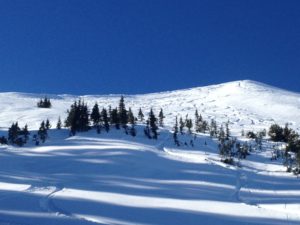There are a lot of ways to look at the avalanche problem. There is a risk to oversimplification but equally there is a risk to  complicating the hazard. With that in mind how can someone that has limited experience or limited knowledge start the process of making a decision? Hopefully the bullet points below can help you.
complicating the hazard. With that in mind how can someone that has limited experience or limited knowledge start the process of making a decision? Hopefully the bullet points below can help you.
- Know when you are in avalanche terrain. Know the angle of the terrain you are on or are about to go on and learn the common angle for avalanches in your area. As a standard the bullseye is between 33 and 43 degrees. So measure, measure, measure both with maps or in the field till you develop a good estimation ability. Remember an icy 40 degree slope can seem very steep and a 40 degree slope with softer snow may not seem very steep at all.
- Know the danger rating and believe it. Considerable and above is serious risk. High and extreme should be avoided completely to the point it’s worth buying a ticket at the ski area.
- Know the avalanche problem and how that affects your ability to see the problem. If it is New Snow there may be a variable based on elevation due to precipitation rate but where there is enough snow (10 inches new snow or more) the problem is widespread. If the problem is Wind Slab learn to recognize where the wind has blown the snow based on the “look” of the snow and the direction the slope faces. If the problem is a Wet Slab, well then if it is warm you have a problem. If the problem is Cornice Fall, stay away from slopes with cornices. Persistent or Deep Slab problems are hard to manage so be conservative, again when there is a Persistent or Deep Slab problem stay on terrain less than 33 degrees and even below 30 degrees if the avalanche forecast is Considerable. With the Persistent and Deep Slab you need to consider connected slopes and terrain above as well since those hazards are more prone to remote triggering. If those problems are widespread or very reactive go to the ski area, generally in those conditions the danger rating will be high or extreme.
- Watch the weather to see if it is stressing the the snow. Is it getting warmer than the forecast expected, is the slope cooling rapidly, is the slope getting loaded by a local wind event not in the forecast or by a snow squall or snow shower not predicted. Is something happening with the weather that the danger forecast and weather forecast did not expect.
- Is the avalanche survivable? Look at the slope, if it were icy and you fell down it could you survive? If not is there an alternative line? This may seem extreme but if the slope slides you will fall down it. Hitting rocks or trees or getting flushed over a cliff isn’t softer because you are surrounded by moving snow. Harder to perceive, is if the bottom of the slope will collect snow such that you will be buried too deep to rescue, if you are buried by 6 feet or more of snow you’re likely going to be a fatality.
- Go one at a time through avalanche terrain and plan for a rescue. Have the gear and have a strategy that will only bury one person and the others are in an effective place to get to the victim and uncover them in 15 minutes or less.
Notice there is very little snow science. Snow is hard to know and your ability to collect data and evaluate it is limited particularly if you aren’t out every day or have limited experience. I really hope these strategies help you.
